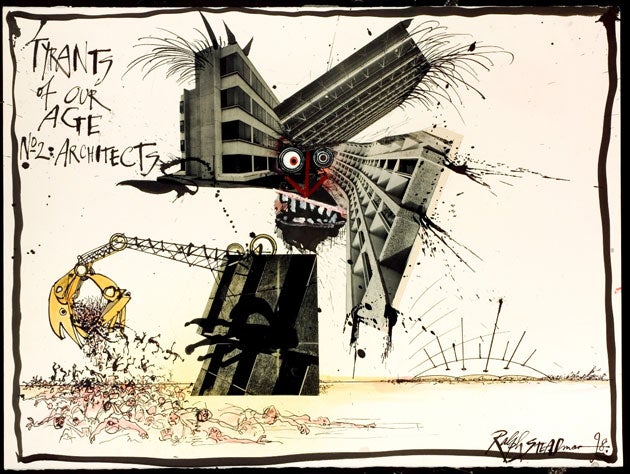Will Self: Frozen music
PsychoGeography: If Brutalism is heavy metal, then what of postmodernism? Can it be equated with drum’n’bass?

Ralph Steadman – last heard of singing sea shanties at the Baltic Centre in Newcastle (how does he do it?) – understands better than most the force of Goethe's dictum that "architecture is frozen music". Mostly it's architects who ponder this, but Ruskin averred that no one could be an architect who was not a supremely sure draughtsman, as well as a proper applicator of paint. Well, Ralph is both, and I suspect that his visceral aversion to the follies of contemporary architects is as much a function of his own edifice complex – he has, as regular readers know, designed a multi-faith place of worship, the Maidstone cathedromoscagogue, that if completed will be the exact same height as the Tower of Babel, but equipped with better signage – as the ghastly heavy metal of theirs.
For that's what the sound of Brutalism undoubtedly is: Deep Purple, or Led Zep, played through megawatt speakers; at once hideously recherché and grindingly painful: ferro-concrete guitar chords, their progressions like garbage chutes, steel-framed window melodies, a drum fill of broken glass. Still, let's make one thing clear: the extraordinary popular music madness of British tower blocks was a collective one, with politicians, developers, architects and even the people themselves compulsively nodding to the beat. The up-thrust of these towers of feedback into the smoggy post-war arena was greeted with enthusiasm by almost all; this was an enactment of several different kinds of fantasy: Marxian equality, the white noise of technology, a Moog synthesiser for living ...
I awoke from pained sleep the other morning – cracked rib on the sinister side – to hear an architectural critic on the World Service observe that in Singapore, Hong Kong and other points further east, the tower block is viewed as a solid embodiment of cultural cohesion: many individuals, choruses of families, all singing from the same Confucian hymn sheet. So, perhaps our show – and gig it was, the roadies put the speaker towers up and took them down again within 30 years, a one-night-stand in architectural time – said more about us than it did about the music.
Besides – I continued to ruminate, as I laced my boots and walked out into the Aeolian music of the Shetland island of Foula – if Brutalism is heavy metal, then what was Modernism, Schoenberg's dodecaphony? And what of post-modernism, can it be equated with Serialism – or drum'n'bass? Or is this a case of one form reversing the progression of the other? Clearly the Little Englander Palladian nostalgia of the Prince of Wales, the Quinlan Terry partnership, and even Barratt Homes, is of a piece with light classical music: Viennese waltzes, frozen in red brick, dancing along the dirty Danubes that have broken their banks and inundated the floodplains where these crescents, drives and cul-de-sacs were unwisely sited.
Foula, where I'd pitched up for a couple of days after attending the Word Play literary festival in Lerwick, was the perfect location for these speculations. Fifteen miles out into the Atlantic, the 2.5- by 3- mile chunk of earth and rock was home to a mere 20 people. When I'd flown in the previous morning – the only passenger on the little twin-engine plane – waiting on hard-packed airstrip were a fire crew of two, who then went off to tend to their crofts. On Foula, the vernacular architecture is a marriage of form, function and depopulation: the crumbling stone-built crofts are as sad as a sung threnody, accompanied by a solo fiddle; while the new buildings have arrived as kits.
Nothing wrong with that – the people who live here haven't come to replay the frozen music of mere human composers, oh no. This place, unlike the contemporary urban scene is no cacophony of styles and modes. Here, the steep green hills mount to the sky – and my feet mounted them. Up on top of the highest of these eminences, the Sneug, a great skua, or bonxie, protecting its territory, dived for my face, but this time I didn't make the previous day's mistake of throwing myself to the ground – hence the cracked rib – but waved cheerily, sending it banking sideways into the void, then plodded on along the ridge to the Kame. Beyond the peak of this green wave the island fell away: a 1,300-foot sheer drop to the sea below. The vista – and I use this word in its fullest connotation – was sublime: mighty stacks, arches hollowed out by the foaming waters, enormous asymmetric chunks of rock flung about holus-bolus. Think of Mahler at his most transcendental – then increase the number of players in each section of the orchestra one-hundredfold, and you wouldn't even get close. Yes, architecture may well be frozen music, but nature – that's a living music, a music at once scored and improvised, a music that requires no players or conductor, and whose composer – if she even exists – seems disinclined to take a bow.
So, Steve Jobs, you can take your iPod, and shove it up your ...
Join our commenting forum
Join thought-provoking conversations, follow other Independent readers and see their replies
Comments